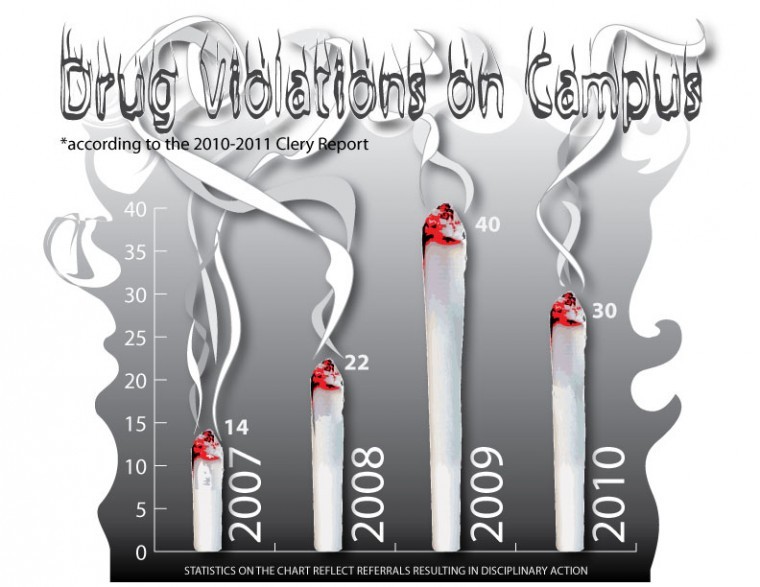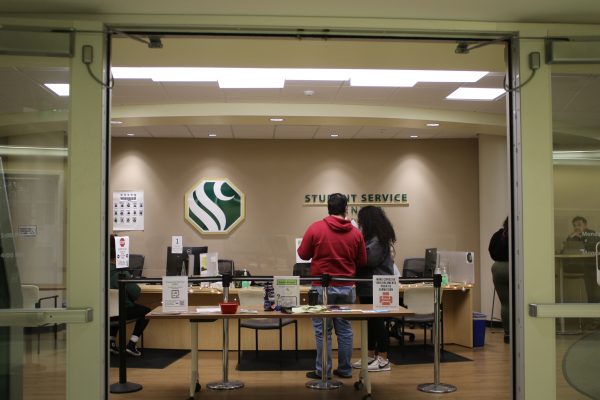Accessibility of drugs on campus sustain college students’ high
November 2, 2011
Increases in the accessibility of marijuana, Adderall, and Ritalin have led to a few of these substances being found more commonly on Sacramento State students, according to the 2011 Clery Act Report.
In 2009, a total of 40 illegal drug-related referrals were reported by the Sacramento State Police Department. By comparison, the total number of referrals in 2008 was 22. In 2010, those numbers have balanced to 30 referrals.
For college students, attaining drugs such as marijuana or Adderall is fairly easy as many students, who wish to remain anonymous for fear of retribution, have said.
“I can find weed anywhere on campus or on the street if I wanted to,” one student said. “A lot of people smoke throughout the week or use Adderall every night to help them study.”
According to the 2010 National Survey on Drug Use and Health, ages 18 to 25 showed the highest rate of marijuana and illicit drug use out of all ages, with 21.5 percent of that age range said they have used drugs in a one-month span.
The number has steadily increased over the years, as the percentage of young adults ages 18 to 25 who said they had used illicit drugs in the one-month span was a mere 19.6 percent in 2008.
“Now that I’m in college, the amount of drugs I have seen has increased a whole lot,” said Daniel Smith, freshman communication studies major.”It seems like everyone has tried some sort of drug in college.”
According to the 2010 National Survey on Drug Use and Health, from 2009 to 2010 the percentage of 18- to 20-year-olds in the U.S. who have used illicit drugs in the past month increased from 22.2 percent to 23.1 percent. The percentage for this age group was far ahead of any other in the category.
“The most two common things officers typically find in the possession of students are marijuana and alcohol,” said University Police spokesman Cpl. Scott Christian.
He said If the person is a student, officers typically would also make a referral to Student Affairs for a review to determine if any student conduct policies may have been violated.
Marijuana has become a popular drug in California since Proposition 215 passed in 1996, allowing medicinal marijuana to be legal for California residents who get approval from a licensed physician.
In 2003, SB 420 passed to add protection for patients using medicinal marijuana from “criminal prosecution or sanction” if they are caught with possession of marijuana.
Once a student turns 18, he or she can apply for a medicinal marijuana card without parental consent and without anyone knowing.
There are 104 medical marijuana dispensaries in Sacramento alone, with even more in San Jose, Los Angeles and San Francisco.
The reason why the amount of drug-related referrals has slightly decreased could be because of the increase of medical marijuana card holders in Sacramento.
“I think the police fine those who are caught and then send us on our way. They know a lot of students have med cards now,” said another student who did not want to be identified for fear of retribution.
The amount of marijuana has a large impact on what kind of discipline police use on a student, as medical marijuana card owners are limited to possessing eight ounces.
“If the person is a student, officers typically would also make a referral to Student Affairs,” Christian said. “It also depends on the amount of the drug in the person’s possession (in the case of possession for sales), whether they were in a motor vehicle, or if they were under the influence at the time of contact.”
Adderall has also become a booming drug for college students, as it is intended for patients with Attention Deficit Hyperactivity Disorder to help them focus.
Sac State students are using it for study sessions or “all-nighters” before a big exam or final, said another Sac State student who wished to remain anonymous.
“I’ve used it and it really helps me focus,” the student said. “When I’m studying I have so many distractions that prevent me from getting work done. Adderall fixes that.”
Adderall has not only been a common study drug at Sac state, but nationwide. A study conducted at the University of Kentucky said 30 percent of students said they have used either Adderall – or another ADHD drug, Ritalin – for studying.
“I’ve never used Adderall before, but I would like to,” said an anonymous Sac state student.
He said he believes from what he has heard from friends and fellow students, the drug can impact one’s study habits tremendously.
According to WebMD, Adderall can cause loss of appetite, weight loss, stomach pain, nausea or vomiting, trouble sleeping and headaches.
“I don’t care if I get a little dizzy; Adderall has helped my grades improve a lot,” said one Sac State student. “I’ll take a chance on it.”
Russell Preston can be reached at [email protected]









































































































































